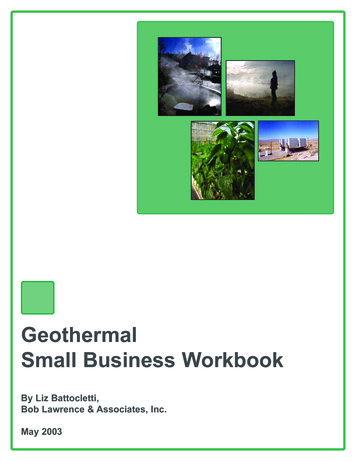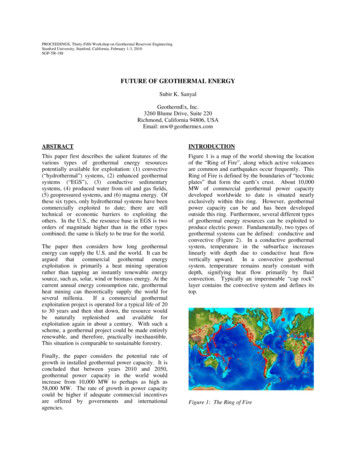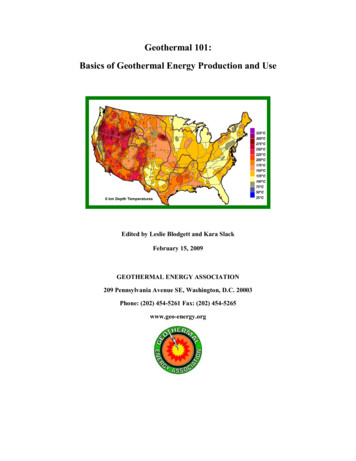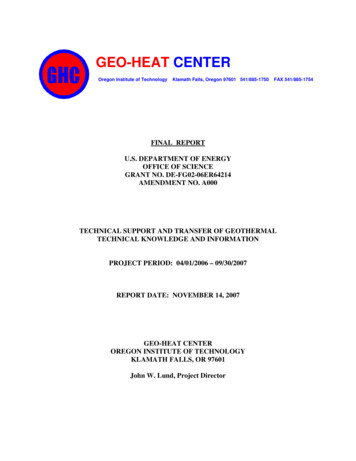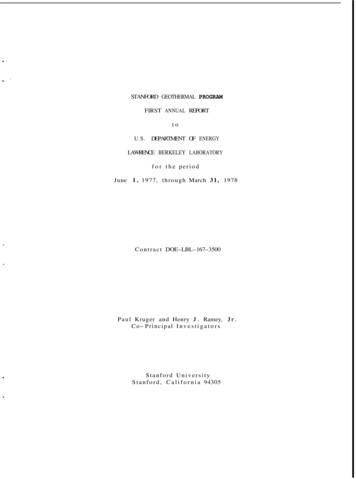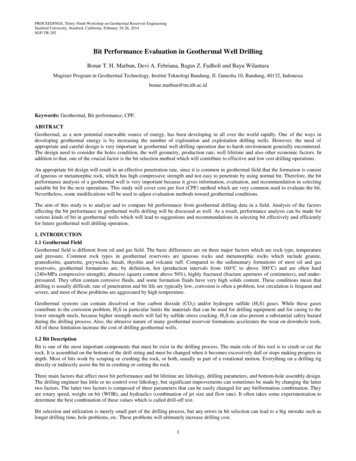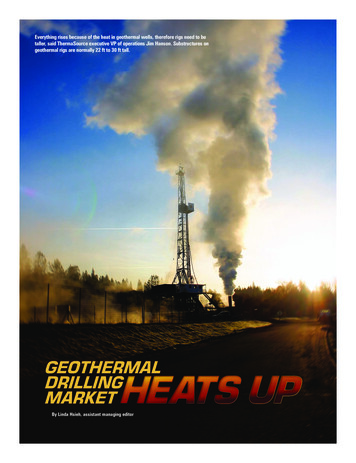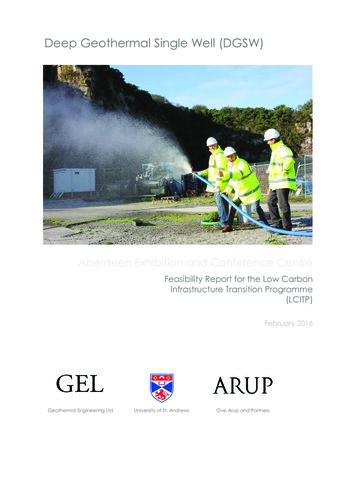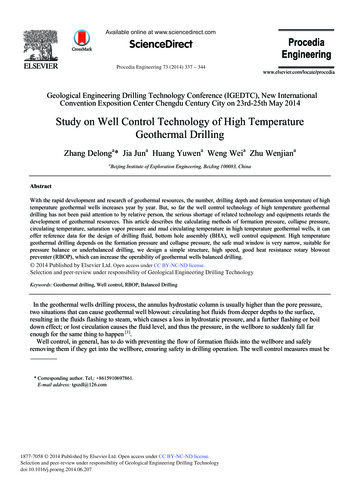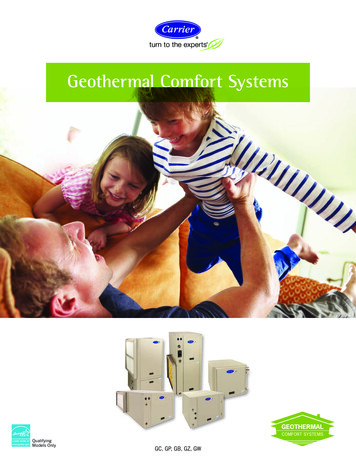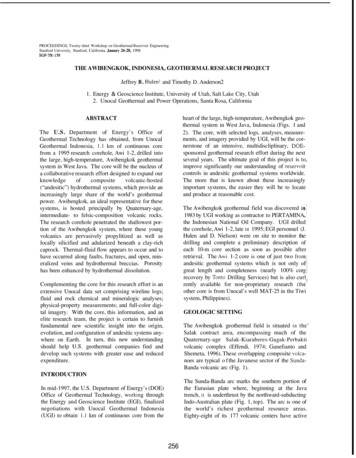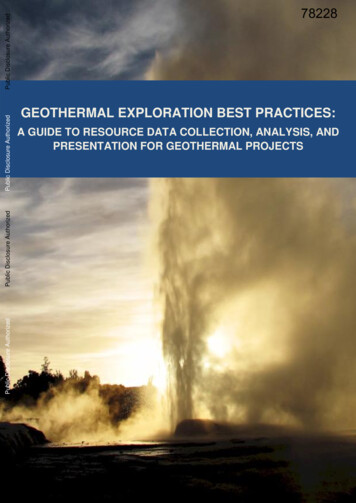
Transcription
Public Disclosure AuthorizedPublic Disclosure AuthorizedPublic Disclosure AuthorizedPublic Disclosure Authorized78228GEOTHERMAL EXPLORATION BEST PRACTICES:A GUIDE TO RESOURCE DATA COLLECTION, ANALYSIS, ANDPRESENTATION FOR GEOTHERMAL PROJECTS
DISCLAIMERThe conclusions and judgments contained in this report should not be attributed to, and do not necessarilyrepresent the views of, IGA Service GmbH, GeothermEx Inc., Harvey Consultants Ltd, IFC, GNS Science, GZB,Munich Re, the International Geothermal Association, GNS Science, the Turkish Geothermal Association, HotDry Rock Ltd, Harbourdom GmbH, the Global Environment Facility, Geowatt AG, National Institute of AdvancedIndustrial Science and Technology of Japan, or any of their Boards of Directors, Executive Directors,shareholders, affiliates, or the countries they represent. These organizations do not guarantee the accuracy ofthe data in this publication and accept no responsibility for any consequences of their use.This report does not claim to serve as an exhaustive presentation of the issues it discusses and should not beused as a basis for making commercial decisions. Please approach independent legal counsel for expert adviceon all legal issues.The material in this work is protected by copyright. Copying and/or transmitting portions or all of this work maybe a violation of applicable law. IGA Service GmbH encourages dissemination of this publication and herebygrants permission to the user of this work to copy portions of it for the user‘s personal, noncommercial use. Anyother copying or use of this work requires the express written permission of IGA Service GmbH.Copyright 2013 IGA Service GmbHc/o Bochum University of Applied Sciences (Hochschule Bochum)Lennershofstr. 140, D-44801 Bochum, GermanyMarch 2013
SUPPORTED BY:
ABOUT THE REPORTThis report has been written by GeothermEx Inc., USA, and Dr. Colin Harvey of Harvey Consultants Ltd, of NewZealand.This Best Practice Guide for Geothermal Exploration was produced for IFC by GeothermEx, Inc. Ownership ofthe Guide has been transferred to IGA Service GmbH under the terms of a cooperation agreement. Additionsand edits of the text were carried out by Dr. Colin Harvey of New Zealand. The principal reviewer was Dr.Graeme Beardsmore of Australia. The Guide was also reviewed by Tom Harding-Newman, Patrick Avato, andAlexios Pantelias of IFC; Magnus Gehringer of the World Bank; Matthias Tönnis and Stephan Jacob of MunichRe; Dr. Orhan Mertoglu and Nilgun Basarir of the Turkish Geothermal Association; Dr. Horst Rüter ofHarbourdom GmbH; Dr. Ladislaus Rybach of GEOWATT AG; and Dr. Kasumi Yasukawa of the National Instituteof Advanced Industrial Science and Technology, Japan.The work is funded by the Global Environment Facility (GEF).About IGA Service GmbH and the International Geothermal AssociationIGA Service GmbH was founded in 2009 in Germany and is owned by the International Geothermal Association(the ―IGA‖). The main objectives of IGA Service GmbH are the promotion and deployment of geothermal energyand its application through the support of the IGA and its statutory tasks. Activities include facilitating andpromoting the development, research, and use of geothermal energy globally through the hosting of congresses,workshops and other events, publishing in print media and online, exchanging knowledge and best practices inresearch as well as consulting and compiling relevant reports. For more information, visit www.geothermalenergy.org.About IFCIFC, a member of the World Bank Group, creates opportunity for people to escape poverty and improve theirlives. We foster sustainable economic growth in developing countries by supporting private sector development,mobilizing private capital, and providing advisory and risk mitigation services to businesses and governments.For more information, visit www.ifc.org.About the Global Environment FacilityThe Global Environment Facility (GEF) was established in 1991 as the financial mechanism of the mainmultilateral environmental agreements. Currently, the GEF is the largest public funder worldwide of projectsaiming to generate global environmental benefits, while supporting national sustainable development initiatives.For more information, visit www.gef.org.About GeothermEx, Inc.Founded in 1973, GeothermEx is a U.S. corporation that specializes exclusively in providing consulting servicesin the exploration, development, assessment, operation, and valuation of geothermal energy. GeothermEx hasparticipated in geothermal projects in 56 countries, supporting the development of 7,000 MW of geothermalpower and US 12 billion in project finance. GeothermEx was acquired by Schlumberger in 2010. For moreinformation, visit www.geothermex.com.
About Harvey Consultants LtdThe Principal of Harvey Consultants Ltd, Dr. Harvey, is a former manager of the geothermal division of GNSScience, a government owned CRI (Crown Research Institute). Dr. Harvey, a geochemist, has worked andmanaged geothermal projects in more than 20 countries over a 30 year period.About Munich ReMunich Re stands for exceptional solution-based expertise, consistent risk management, financial stability, andclient proximity.The Munich Re Group operates in all lines of insurance, with around 47,000 employeesthroughout the world. Our business model is based on the combination of primary insurance and reinsuranceunder one roof. We take on risks worldwide of every type and complexity, and our experience, financial strength,efficiency, and first-class service make us the first choice for all matters relating to risk. Our client relationshipsare built on trust and cooperation. For more information, visit www.munichre.com.About GNS Science, New ZealandGNS Science is New Zealand‘s leading provider of Earth science research and consultancy services, and aworld-leader in the understanding and sustainable development of the Earth's cauldron of energy for over 50years. The 40 strong GNS Geothermal team is internationally recognized for innovative, robust geoscientificresearch, expertise, and consultancy advice.Specialists in geology, geophysics and geochemistry; GNSScience ensures that companies looking to increase their geothermal capacity have the sound knowledge topower their growth. GNS Science has provided expert assistance for successful geothermal projects in over 35countries, including New Zealand, Japan, Philippines, Indonesia, Chile and other countries worldwide. For moreinformation, visit www.gns.cri.nz.About GZB – The International Geothermal Centre of BochumThe GeothermalCenter (GZB) is a joined research establishment of science and economy with a close link toadministration and politics. With its broad anchorage the GZB provides a competence and information center tothe public in regard to all Queries concerning the utilization and extraction of geothermal energy. For moreinformation, visit http://www.geothermie-zentrum.de/en.html.
Contents1.02.03.0PURPOSE AND STRUCTURE OF THE GUIDE . 31.1Geothermal Exploration Best Practices. 31.2Outline. 31.3Exclusions . 41.4Relevant Literature . 4THE PROCESS OF GEOTHERMAL DEVELOPMENT . 52.1Introduction . 52.2Phase 1 – Preliminary Survey . 62.3Phase 2 – Exploration . 82.3.1Conceptual Modeling . 92.3.2Numerical Modeling . 92.3.3Non-Technical Data Compilation .102.3.4Prefeasibility Study .102.4Phase 3 – Test Drilling .102.5Phase 4 – Project Review and Feasibility .112.6Phase 5 – Field Development .112.7Phase 6 – Power Plant Construction.122.8Phase 7 – Commissioning and Operation .12GUIDELINES FOR PRESENTATION OF EXPLORATION DATA TO FUNDING ENTITIES .133.1Introduction .133.2Preliminary Information .133.3Environmental Impact and Resource Protection .133.4Collection of Baseline Data .143.5Literature Review .143.6Satellite Imagery .163.7Active Geothermal Features .163.8Geology.173.9Geochemistry .173.10 Geophysics .203.11 Conceptual Model .223.12 Numerical Modeling .243.13 Non-Technical Data Compilation.243.14 Financial Justification to Proceed to Phase 4 (Test Drilling) .254.0RISK.264.1Introduction .264.2Exploration Risk .274.3Test Drilling Risk .274.4Resource Sustainability.28Geothermal Exploration Best Practices1
5.0FINANCING GEOTHERMAL PROJECTS .295.1Introduction .295.2Private Sector Funding.315.3Public Sector Funding .315.4Possible Sources of Funding Support to Reduce Risk .315.5Successful Business Models .31AppendicesAPPENDIX A1:DETAILS OF PROJECT STAGES .34A1.1 Introduction .34A1.2 Phases of Geothermal Development .34A1.3 Phase 1 – Preliminary Survey .34A1.3.1Literature Search .34A1.3.2Non-Resource Data Collection .35A1.4 Phase 2 – Exploration Survey .35A1.4.1Regional Resource Exploration .35A1.4.2Localized Resource Evaluation .36A1.4.3Conceptual model .37A1.4.4Numerical Model .38A1.5 Phase 3 – Test Well Drilling .42A1.6 Phase 4 – Project Review and Planning .43A1.7 Phase 5 – Field Development .43A1.8 Phase 6 – Power Plant Construction.44A1.9 Phase 7 – Commissioning and Operation .44APPENDIX A2:GEOTHERMAL RESOURCE DATA COLLECTION .45A2.1 Active Geothermal Features .45A2.2 Geology.46A2.3 Geochemistry .51A2.4 Geophysics .56APPENDIX A3:DATA CHECKLIST FOR PROJECT REVIEW AND EXPLORATION RISK INSURANCEAPPLICATIONS .64APPENDIX A4:EXAMPLE TABLE OF CONTENTS FOR RESOURCE REVIEW REPORT .68Geothermal Exploration Best Practices2
1.01.1PURPOSE AND STRUCTURE OF THE GUIDEGEOTHERMAL EXPLORATION BEST PRACTICESExploration best practices for any natural resource commodity should aim to reduce the resource risk prior tosignificant capital investment, for a fraction of the cost of the planned investment. For geothermal energy, thehigh risks cost of proving the resource is one of the key barriers facing the industry. This guide lays out bestpractices for geothermal exploration to assist geothermal developers and their contractors to address these risksin a cost-sensitive manner, raising project quality.Companies that can demonstrate that their project hasfollowed such best practices will find it easier to access finance. In the same way, this guide will be of use tofinancers of geothermal projects, assisting the assessment of projects to ensure project risks have beenaddressed.A test of best practice for geothermal exploration is the degree to which each principal resource risk element isaddressed.Principal resource risks for geothermal energy are temperature (or enthalpy) and depth of theresource, as well as output and sustainability of flow from producing wells. Each component of a geothermalexploration program should be clearly designed to address one or more of these risks, and each risk componentshould be addressed in some manner. By the completion of the Exploration Phase, a developer should be ableto provide potential financiers with at least a qualified (if not quantified) estimate of the uncertainty associatedwith forecasting thermal energy production.Formal ‗Geothermal Reporting Codes‘ now exist in at least two countries—Australia and Canada. These Codesexpound the principles of transparency, materiality, and accountability with respect to the presentation ofgeothermal exploration results and estimates of future geothermal power generation. Exploration best practicesshould, at the very least, emulate these principles if not fully comply with one of the Codes.All relevantexploration results should be clearly and fully presented. A competent, qualified, and experienced person shouldaccept responsibility for the interpretations.1.2OUTLINEThis guide provides potential developers with an outline of the various methodologies and strategies employed inthe exploration for geothermal resources for power generation. It does this within the context of the typicalgeothermal development process from preliminary surveying through to power plant development.This first chapter provides an introduction to the topic and the scope of the report.Chapter 2 provides an overview of the typical sequence of phases in any geothermal exploration anddevelopment program. This guide follows a seven phase process, in line with ESMAP‘s Geothermal Handbook(2012). Others in the sector may describe a three or five phase process, but the core elements of each are thesame.Chapter 3 focuses on the Exploration Phase and provides a detailed breakdown of the methodologies and datathat should be collected to minimize resource risk prior to presentation to funding entities.Chapter 4 discusses the various facets of risk relating to geothermal development, including resource risk andfinancial risk.Geothermal Exploration Best Practices3
Chapter 5 presents a summary of funding models that have been successfully employed for geothermaldevelopment in various countries around the World, and which may be investigated elsewhere.A series of appendices provide greater detail on the exploration methodologies and techniques. The guide canbe utilized both as a tool for working through a project, and as an illustration of the geothermal developmentprocess.1.3EXCLUSIONSThis guide specifically addresses the typical development pathway for hydrothermal geothermal resources. Itmay not be wholly applicable to exploration for low temperature geothermal resources, ‗Enhanced (orEngineered) Geothermal Systems‘ (EGS, or ‗Hot Dry Rock‘), or other less conventional or unconventionalgeothermal developments.This guide does not address policy, regulatory, and planning frameworks and, as such, is of limited use togovernments, development banks or other international funding agencies in designing programs to promoteinvestment in geothermal energy. The recently released ESMAP Geothermal Handbook (2012), which can beconsidered a companion document to this guide, addresses these areas of interest.1.4RELEVANT LITERATUREA very large body of literature now exists relating to geothermal development. A comprehensive database ofpublished papers can be accessed through the website of the International Geothermal Association(www.geothermal-energy.org) or its member organizations.Overview publications that may provide usefulbackground reading are listed in the box below. Planning and Finance: - World Bank: ESMAP Geothermal Handbook: Planning and Financing PowerGeneration: Technical Report 002/12. Available at www.esmap.org/Geothermal Handbook Geothermal Generation: - World Geothermal Congress: World Geothermal Generation in 2010 – R.Bertani; in Proceeding from WGC 2010. Available at 0008.pdf Risk: - Deloitte 2008 Geothermal Risk Mitigation. Department of Energy/Office of Energy Efficiency andRenewable Energy Program. February 15. Available atwww1.eere.energy.gov/geothermal/pdfs/geothermal risk mitigation.pdf Environmental: – IFC/World Bank 2007: Environmental Health and Safety Guidelines for Geothermal PowerGeneration. Available at http://tinyurl.com/ck4jeqo Project Costs: - New Zealand Geothermal Association: Assessment of Current Costs of Geothermal PowerGeneration in New Zealand (2007 basis). Available at http://grsj.gr.jp/iga/igafiles/NZ gpp cost estimate 2007basis.pdf Reporting Codes: - Australian Geothermal Energy Association: Australian Code for Reporting ofExploration Results, Geothermal Resources and Geothermal Reserves, Second Edition (2010). Available athttp://www.agea.org.au/media/docs/the geothermal reporting code ed 2.pdfGeothermal Exploration Best Practices4
2.02.1THE PROCESS OF GEOTHERMAL DEVELOPMENTINTRODUCTIONThis chapter describes the typical process of assessing and developing geothermal power projects. It must beappreciated, however, that every geothermal project is unique, defined by its local geological and marketconditions: No two geothermal projects follow exactly the same development path.Therefore, themethodologies, techniques, and project timeline for any geothermal project will be unique to that one resource orproject and processes.Historically, many of the early geothermal projects were developed in a non-systematic manner. There were noclear guidelines for the geothermal development process. The first time geothermal power was harnessed forthelectricity production was in Italy in the early part of the part of the 20 century using shallow steam from an areawhere surface discharges were clearly evident. In New Zealand in the 1950‘s, the Wairakei developments wereinitially justified on the basis of very high surface heat flows and many surface features (geysers and altered hotground).There was no best practice guide at this time. It is only with experience that the stages or phases of how todevelop a geothermal resource have become more clearly defined.Even today there are differences inmethodologies and techniques between different countries and different agencies.This guide generally follows a seven phase process of developing geothermal projects, in line with the ESMAPGeothermal Handbook (2012):1.Preliminary survey2.Exploration3.Test drilling4.Project review and planning5.Field development6.Power plant construction7.Commissioning and operationOthers may use a three phase (exploration, development, and operation) or a five phase (reconnaissanceexploration, pre-feasibility, feasibility, detailed design and construction, and operation) process, but theunderlying activities will be the same.The primary focus of this guide is on the Preliminary Survey and Exploration Phases of project development.Critical resource data and analyses generated during all phases of geothermal development are integrated intocontinually evolving conceptual models of the resource, which are constantly tested and improved with each newdata set. The following sections describe the various phases of a typical geothermal project.Geothermal Exploration Best Practices5
2.2PHASE 1 – PRELIMINARY SURVEYThe Preliminary Survey Phase involves a work program to assess the already available evidence for geothermalpotential within a specific area (perhaps a country, a territory, or an island). The initial surveying may be regionalor national and essentially involves a literature review of geological, hydrological or hot spring/thermal data,drilling data, anecdotal information from local populations, and remote sensing data from satellites, if available.Example:Most countries have existing data bases of geological and hydrological data. These have usually been gatheredfor other purposes but may very well be useful for guiding early geothermal surveying and exploration. Thepotential explorer/developer should make every effort to collect and analyze these data prior to designing andplanning an additional exploration program. Remote sensing, in particular, is now playing a more significant rolein preliminary surveying for geothermal resources.Information should also be gathered on access issues during the Preliminary Survey Phase. What are thenational, regional, and/or local regulations that might allow or restrict access for exploration activities? Restrictedareas might include National Parks, cultural sites, geological hazards, urban areas, areas of unique flora orfauna, or others. Land use issues are also of importance. Could a geothermal development live harmoniouslywith other existing or possible land uses? It is critical that potential conflicts be identified and assessed at anearly stage in a geothermal project, prior to committing to what might be an expensive exploration program.Different countries will have different requirements.Examples:In Japan, the majority of identified high temperature geothermal resources are located within or adjacent toNational Parks, where access for exploration has, until recently, been forbidden.In Indonesia, over 50% of known high temperature geothermal resources are located within or adjacent toprotected forests or National Parks.In New Zealand, almost half of the identified geothermal resources are in protected areas where development islimited or forbidden.In Turkey, no very hard rules or regulations currently exist regarding geothermal exploitation. A Protected AreaSpecial Committee has been established by the Turkish Government that decides if it is appropriate to drill ageothermal well in a protected area. Access for exploration in National Parks is controlled and limited.The Preliminary Survey Phase should also include an assessment of key environmental issues or factors thatmight impact or be impacted by a geothermal development. As with any power plant development, geothermalpower has its own unique social and environmental impacts and risks that require awareness and management.Making contact with all stakeholders at the early stages of investigation is critical if the developer is to identifypotential sociological or environmental roadblocks that may need to be addressed during the project.Example:Surface water and groundwater quality and water allocations are becoming major issues worldwide. It is criticalto understand the impacts that geothermal developments will have on groundwater availability and quality in thelocal context.Necessary infrastructure such as roads, water, power supplies, and availability of equipment must also beconsidered at an early stage.If roads and bridges have to be constructed in what is frequently steep ormountainous terrain, then the rate of progress for both surface exploration and subsequent drilling may bedelayed.If the project area has a history of mineral and/or water resource exploration then this may provide very usefulbackground or perhaps subsurface information.Geothermal Exploration Best Practices6
The developer also needs to understand the processes for obtaining and retaining legal rights to the geothermalresource throughout the geothermal project. Regulatory issues relevant to obtaining access, land rights for theearly stages of work and for subsequent development, power supply agreements and so on, should beunderstood. Geothermal resources may be either publicly or privately owned. Payments may be required tosecure leases or to obtain options to develop the resource if the detailed exploration is successful. Somecountries legislate geothermal rights under mining laws; others consider them as water rights, while manycountries still have no legal framework for geothermal development. Geothermal permitting processes may befast or very slow. It is critical that these issues be well understood from the outset.All the factors mentioned above can significantly impact the time and cost required to move through the variousphases of project development. Based on this review, the first question to be answered is:Does the area of interest (country, region, or island) have a geological setting or features that may indicate thepresence of an exploitable geothermal resource?If the answer is yes, then the assessment can move to the second question, which is:If suitable indications of geothermal potential exist, is it possible to obtain concessions over the most promisingareas and, if they become productive, how would geothermal power fit with the existing energy infrastructure?In summary,
A test of best practice for geothermal exploration is the degree to which each principal resource risk element is addressed. Principal resource risks for geothermal energy are temperature (or enthalpy) and depth of the resource, as well as output and sustainability of flow from producing wells. Each component of a geothermal
